flat tire Acura Integra 2000 Sedan Owner's Manual
[x] Cancel search | Manufacturer: ACURA, Model Year: 2000, Model line: Integra, Model: Acura Integra 2000Pages: 273, PDF Size: 4.4 MB
Page 9 of 273
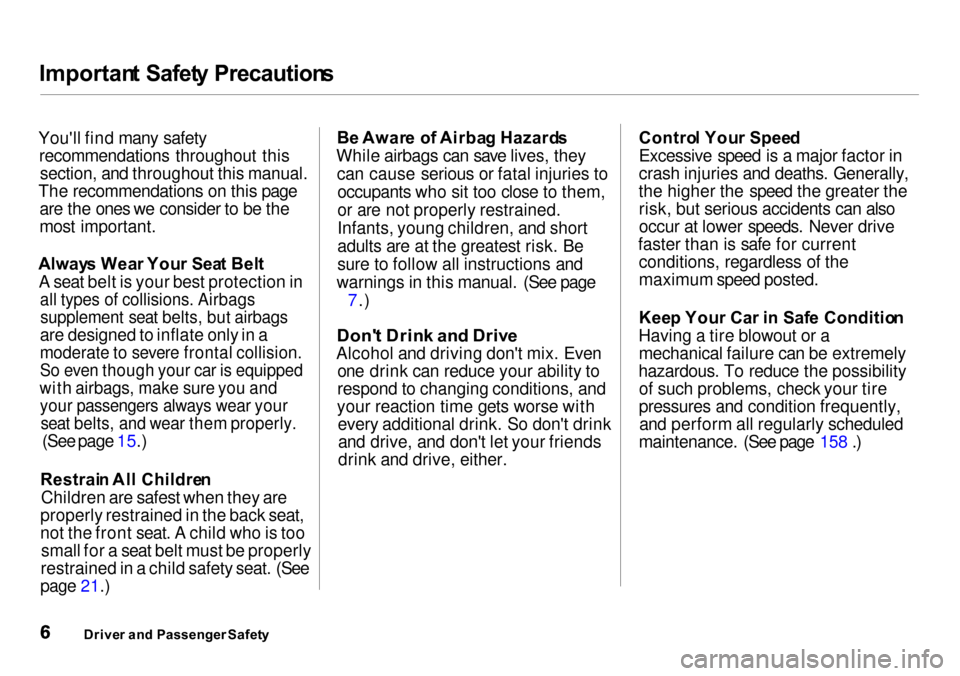
Importan
t Safet y Precaution s
You'll find many safety recommendations throughout thissection, and throughout this manual.
The recommendations on this page are the ones we consider to be the
most important.
Alway s Wea r You r Sea t Bel t
A seat belt is your best protection in
all types of collisions. Airbags
supplement seat belts, but airbags
are designed to inflate only in a
moderate to severe frontal collision.
So even though your car is equipped
with airbags, make sure you and
your passengers always wear your
seat belts, and wear them properly.
(See page 15.)
Restrai n Al l Childre n
Children are safest when they are
properly restrained in the back seat,
not the front seat. A child who is too small for a seat belt must be properly
restrained in a child safety seat. (See
page 21.) B
e Awar e o f Airba g Hazard s
While airbags can save lives, they can cause serious or fatal injuries tooccupants who sit too close to them,
or are not properly restrained.
Infants, young children, and short
adults are at the greatest risk. Be
sure to follow all instructions and
warnings in this manual. (See page 7.)
Don' t Drin k an d Driv e
Alcohol and driving don't mix. Even one drink can reduce your ability to
respond to changing conditions, and
your reaction time gets worse with every additional drink. So don't drinkand drive, and don't let your friends
drink and drive, either. Contro
l You r Spee d
Excessive speed is a major factor in
crash injuries and deaths. Generally,
the higher the speed the greater the risk, but serious accidents can also
occur at lower speeds. Never drive
faster than is safe for current conditions, regardless of the
maximum speed posted.
Kee p You r Car i n Saf e Conditio n
Having a tire blowout or a mechanical failure can be extremely
hazardous. To reduce the possibility of such problems, check your tire
pressures and condition frequently,and perform all regularly scheduled
maintenance. (See page 158 .)
Drive r an d Passenger Safet y
Page 127 of 273
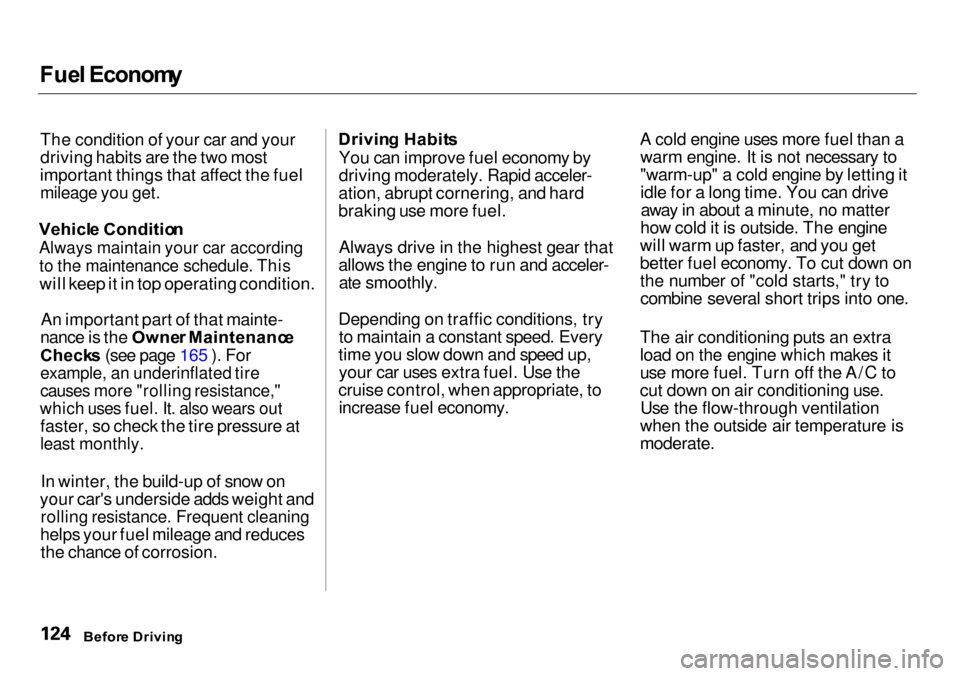
Fue
l Econom y
The condition of your car and your
driving habits are the two most
important things that affect the fuel
mileage you get.
Vehicl e Conditio n
Always maintain your car according
to the maintenance schedule. This
will keep it in top operating condition.
An important part of that mainte-
nance is the Owne r Maintenanc e
Check s (see page 165 ). For
example, an underinflated tire
causes more "rolling resistance,"
which uses fuel. It. also wears out
faster, so check the tire pressure at
least monthly.
In winter, the build-up of snow on
your car's underside adds weight and
rolling resistance. Frequent cleaning
helps your fuel mileage and reduces the chance of corrosion. Drivin
g Habit s
You can improve fuel economy by
driving moderately. Rapid acceler-
ation, abrupt cornering, and hard
braking use more fuel.
Always drive in the highest gear that
allows the engine to run and acceler- ate smoothly.
Depending on traffic conditions, try to maintain a constant speed. Every
time you slow down and speed up, your car uses extra fuel. Use the
cruise control, when appropriate, to increase fuel economy. A cold engine uses more fuel than a
warm engine. It is not necessary to
"warm-up" a cold engine by letting it idle for a long time. You can drive away in about a minute, no matter
how cold it is outside. The engine
will warm up faster, and you get
better fuel economy. To cut down on the number of "cold starts," try to combine several short trips into one.
The air conditioning puts an extra
load on the engine which makes it
use more fuel. Turn off the A/C to
cut down on air conditioning use. Use the flow-through ventilation
when the outside air temperature is
moderate.
Befor e Drivin g
Page 129 of 273
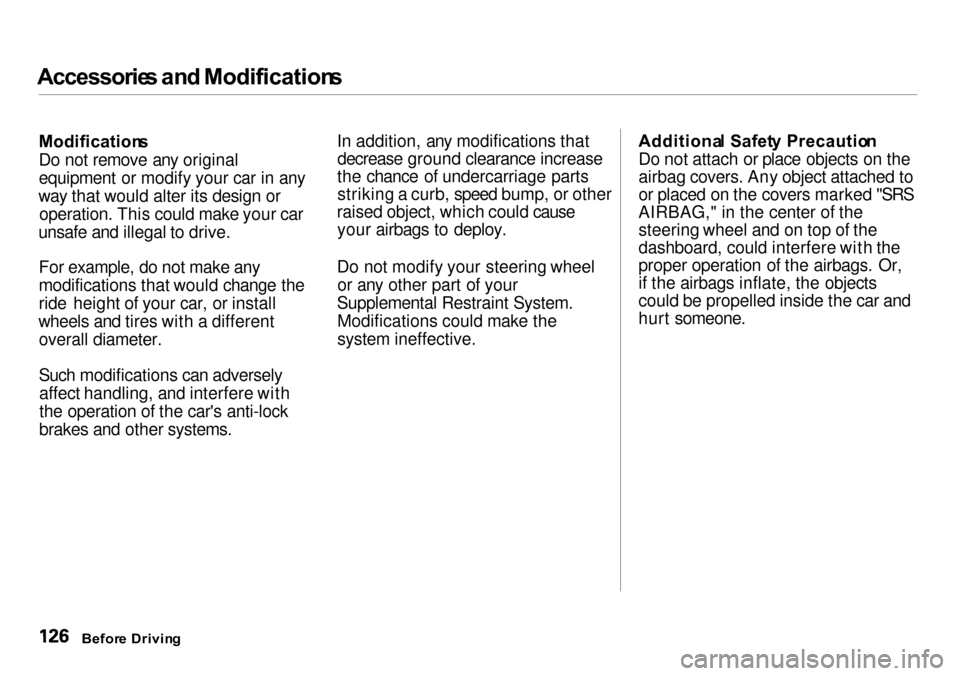
Accessorie
s an d Modification s
Modification s
Do not remove any original
equipment or modify your car in any
way that would alter its design or operation. This could make your car
unsafe and illegal to drive.
For example, do not make any
modifications that would change the
ride height of your car, or install
wheels and tires with a different overall diameter.
Such modifications can adverselyaffect handling, and interfere with
the operation of the car's anti-lock
brakes and other systems. In addition, any modifications that
decrease ground clearance increase
the chance of undercarriage parts striking a curb, speed bump, or other
raised object, which could cause your airbags to deploy.
Do not modify your steering wheel or any other part of your
Supplemental Restraint System. Modifications could make the
system ineffective. Additiona
l Safet y Precautio n
Do not attach or place objects on the
airbag covers. Any object attached to
or placed on the covers marked "SRS
AIRBAG," in the center of the steering wheel and on top of the
dashboard, could interfere with the
proper operation of the airbags. Or, if the airbags inflate, the objects
could be propelled inside the car and
hurt someone.
Befor e Drivin g
Page 153 of 273
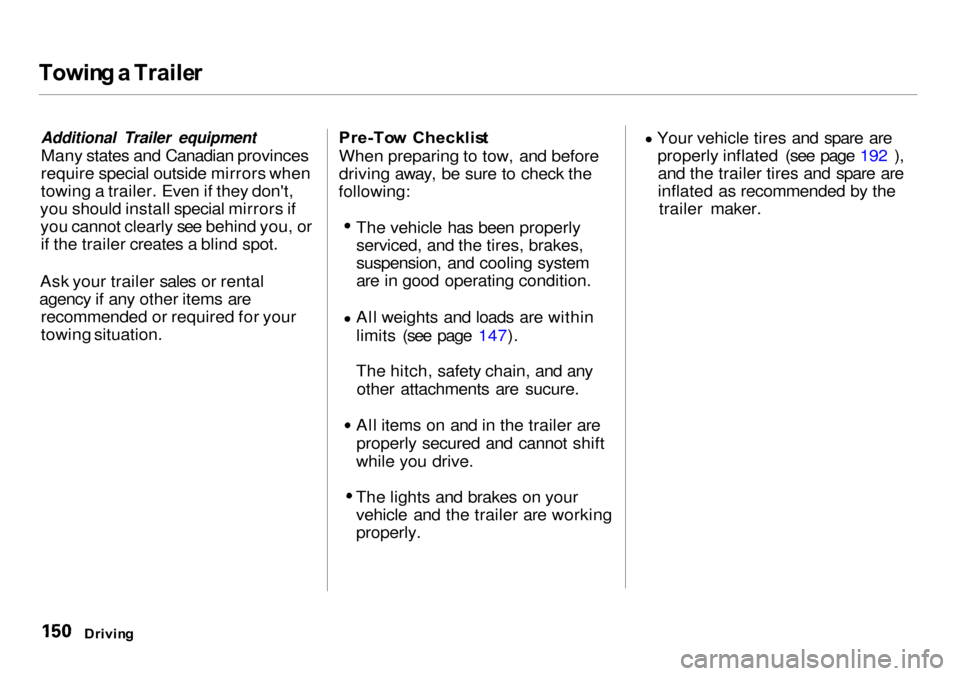
Towin
g a Traile r
Additional Trailer equipment
Many states and Canadian provinces
require special outside mirrors when
towing a trailer. Even if they don't,
you should install special mirrors if you cannot clearly see behind you, orif the trailer creates a blind spot.
Ask your trailer sales or rental
agency if any other items are recommended or required for your
towing situation. Pre-To
w Checklis t
When preparing to tow, and before driving away, be sure to check the
following:
The vehicle has been properlyserviced, and the tires, brakes,
suspension, and cooling system
are in good operating condition. All weights and loads are within
limits (see page 147).
The hitch, safety chain, and any other attachments are sucure. All items on and in the trailer are
properly secured and cannot shift
while you drive. The lights and brakes on your
vehicle and the trailer are working
properly. Your vehicle tires and spare are
properly inflated (see page 192 ),and the trailer tires and spare are
inflated as recommended by the trailer maker.
Drivin g
Page 156 of 273
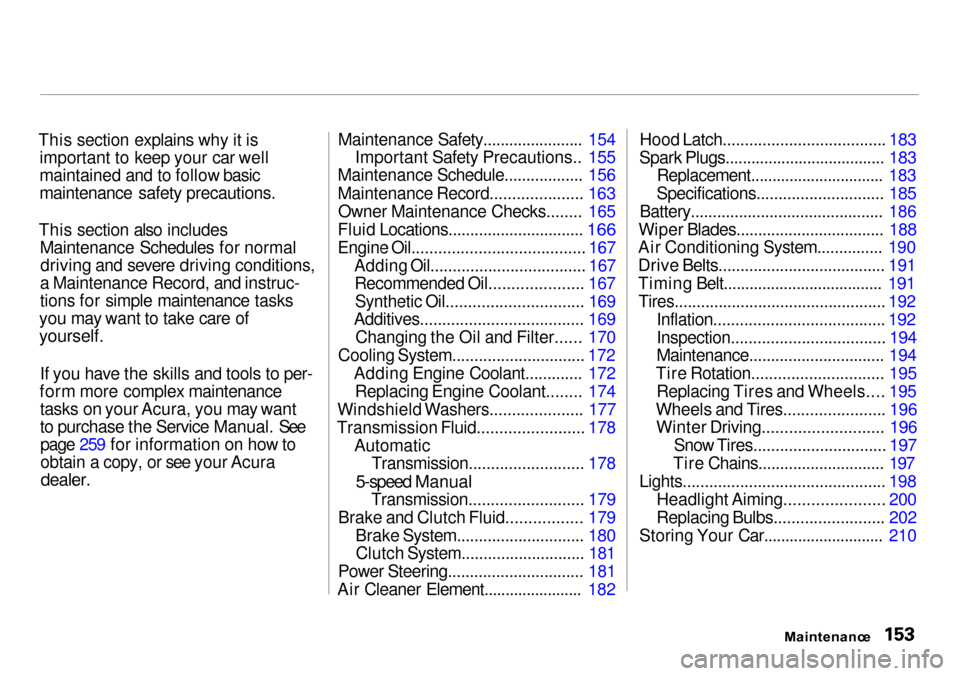
This section explains why it is important to keep your car well
maintained and to follow basic
maintenance safety precautions.
This section also includes Maintenance Schedules for normaldriving and severe driving conditions,
a Maintenance Record, and instruc-
tions for simple maintenance tasks
you may want to take care of
yourself.
If you have the skills and tools to per-
form more complex maintenance tasks on your Acura, you may want
to purchase the Service Manual. Seepage 259 for information on how to
obtain a copy, or see your Acura
dealer.
Maintenance Safety....................... 154
Important Safety Precautions.. 155
Maintenance Schedule.................. 156
Maintenance Record..................... 163
Owner Maintenance Checks........ 165
Fluid Locations............................... 166
Engine Oil......................................
. 167
Adding Oil................................... 167
Recommended Oil..................... 167
Synthetic Oil............................... 169
Additives..................................... 169
Changing the Oil and Filter...... 170
Cooling System.............................. 172 Adding Engine Coolant............. 172Replacing Engine Coolant........ 174
Windshield Washers..................... 177
Transmission Fluid........................ 178 AutomaticTransmission.......................... 178
5-speed Manual
Transmission.......................... 179
Brake and Clutch Fluid................. 179 Brake System............................. 180Clutch System............................
181
Power Steering..............................
. 181
Air Cleaner Element....................... 182 Hood Latch..................................... 183
Spark Plugs..................................... 183 Replacement............................... 183
Specifications............................. 185
Battery............................................ 186
Wiper Blades.................................. 188
Air Conditioning System............... 190
Drive Belts...................................... 191
Timing Belt..................................... 191
Tires................................................ 192 Inflation....................................... 192
Inspection...................................
194
Maintenance............................... 194
Tire Rotation.............................. 195 Replacing Tires and Wheels.... 195
Wheels and Tires....................... 196 Winter Driving........................... 196
Snow Tires.............................. 197
Tire Chains............................. 197
Lights.............................................. 198
Headlight Aiming.....................
. 200
Replacing Bulbs......................... 202
Storing Your Car............................ 210
Maintenance
Page 195 of 273

Tire
s
To safely operate your car, your tires must be the proper type and size, in
good condition with adequate tread,and correctly inflated. The following
pages give more detailed information on how and when to check air
pressure, how to inspect your tires for damage and wear, and what to do
when your tires need to be replaced.
Inflatio
n
Keeping the tires properly inflated
provides the best combination of handling, tread life and riding
comfort. Underinflated tires wear
unevenly, adversely affect handling and fuel economy, and are more
likely to fail from being overheated. Overinflated tires can make your car
ride more harshly, are more prone to damage from road hazards, and wear
unevenly.
We recommend that you visually check your tires every day. If you
think a tire might be low, check it immediately with a tire gauge. Use a gauge to measure the air
pressure at least once a month. Even
tires that are in good condition may
lose one to two psi (10 to 20 kPa, 0.1
to 0.2 kgf/cm2) per month. Remember to check the spare tire at
the same time you check all the
other tires.
Check the pressure in the tires when
they are cold. This means the car
has been parked for at least three
hours. If you have to drive the car
before checking the tire pressure, the tires can still be considered
"cold" if you drive less than 1 mile
(1.6 km).
Maintenanc e
Using tires that are excessively
worn or improperly inflated can
cause a crash in which you can
be seriously hurt or killed.
Follow all instructions in this
owner's manual regarding tire
inflation and maintenance.
Page 196 of 273
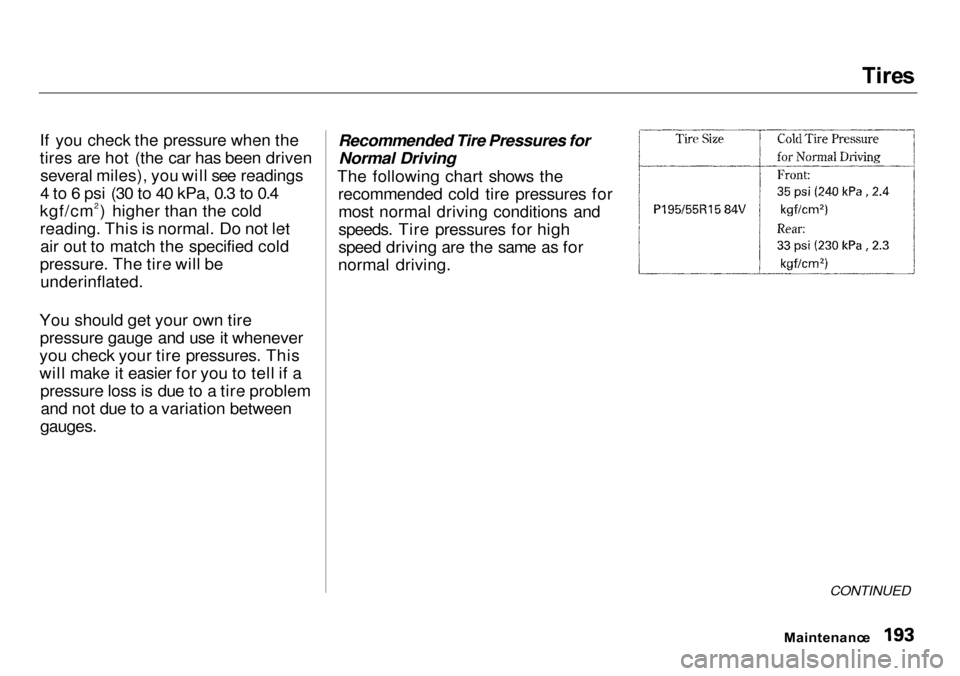
Tire
s
If you check the pressure when the
tires are hot (the car has been driven several miles), you will see readings
4 to 6 psi (30 to 40 kPa, 0.3 to 0.4
kgf/cm2) higher than the cold
reading. This is normal. Do not let air out to match the specified cold
pressure. The tire will be underinflated.
You should get your own tire pressure gauge and use it whenever
you check your tire pressures. This
will make it easier for you to tell if a pressure loss is due to a tire problemand not due to a variation between
gauges.
Recommended Tire Pressures for
Normal Driving
The following chart shows the recommended cold tire pressures formost normal driving conditions and
speeds. Tire pressures for high
speed driving are the same as for
normal driving.
CONTINUED
Maintenanc e
Page 197 of 273
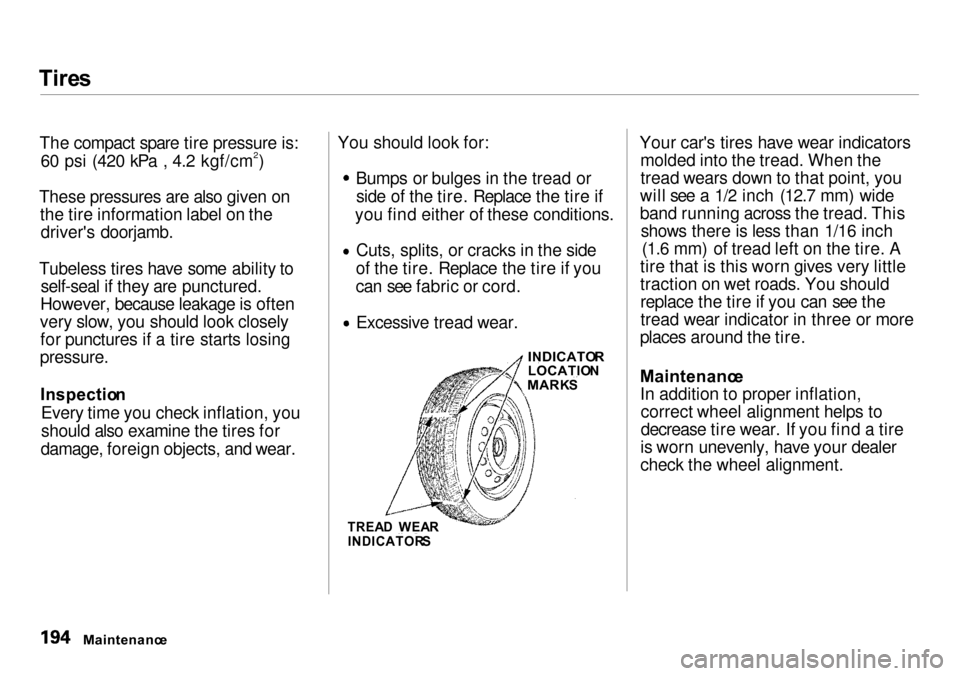
Tire
s
The compact spare tire pressure is: 60 psi (420 kPa , 4.2 kgf/cm2)
These pressures are also given on the tire information label on thedriver's doorjamb.
Tubeless tires have some ability to self-seal if they are punctured.
However, because leakage is often
very slow, you should look closely for punctures if a tire starts losing
pressure.
Inspectio n
Every time you check inflation, you
should also examine the tires for
damage, foreign objects, and wear. You should look for: Bumps or bulges in the tread or
side of the tire. Replace the tire if
you find either of these conditions. Cuts, splits, or cracks in the side
of the tire. Replace the tire if you
can see fabric or cord. Excessive tread wear.
Your car's tires have wear indicators
molded into the tread. When the
tread wears down to that point, you
will see a 1/2 inch (12.7 mm) wide
band running across the tread. This shows there is less than 1/16 inch (1.6 mm) of tread left on the tire. A
tire that is this worn gives very little
traction on wet roads. You should replace the tire if you can see the
tread wear indicator in three or more
places around the tire.
Maintenanc e
In addition to proper inflation, correct wheel alignment helps to
decrease tire wear. If you find a tire
is worn unevenly, have your dealer
check the wheel alignment.
Maintenanc e
INDICATO
R
LOCATIO N
MARK S
TREA D WEA R
INDICATOR S
Page 222 of 273

Takin
g Car e o f th e Unexpecte d
This section covers the more- common problems that motoristsexperience with their vehicles. It
gives you information about how to safely evaluate the problem and what
to do to correct it. If the problem has stranded you on the side of the road,
you may be able to get going again. If not, you will also find instructionson getting your car towed. Compact Spare Tire....................... 220
Changing a Flat Tire..................... 221
If Your Engine Won't Start........... 226
Nothing Happens or theStarter Motor OperatesVery Slowly......................... 226
The Starter Operates Normally................................. 227
Jump Starting................................. 227
If Your Engine Overheats............. 229Low Oil Pressure Indicator.......... 231
Charging System Indicator........... 232
Malfunction Indicator Lamp........ 233
Brake System Indicator................ 234
Closing the Moonroof................... 235
Fuses............................................... 236 Checking and Replacing........... 237
Emergency Towing...................... 241
Takin g Car e o f th e Unexpecte d
Page 223 of 273
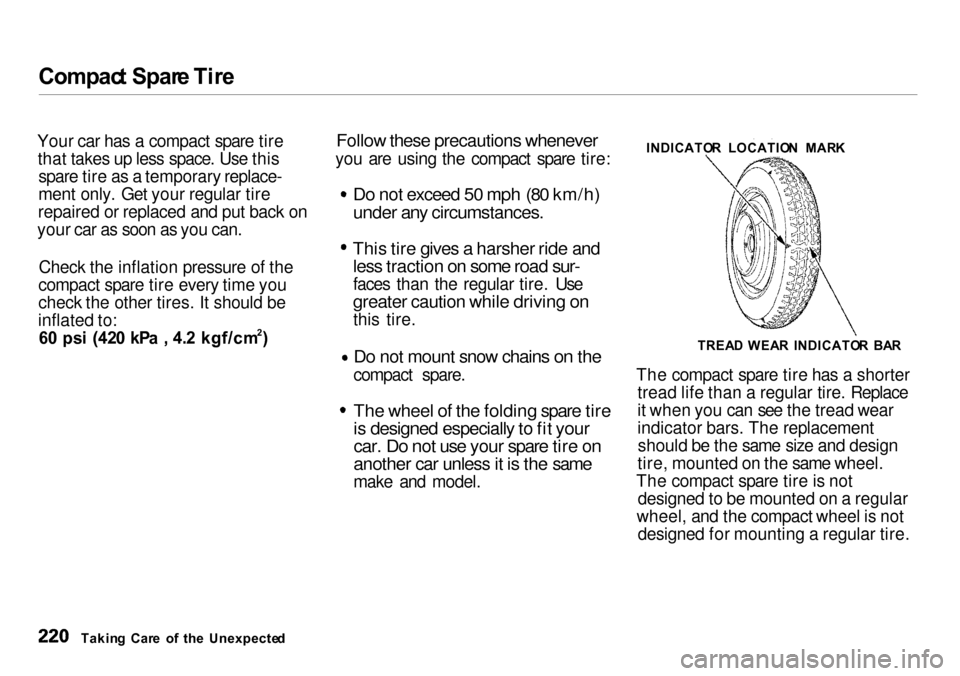
Compac
t Spar e Tir e
Your car has a compact spare tire that takes up less space. Use this spare tire as a temporary replace-
ment only. Get your regular tire
repaired or replaced and put back on
your car as soon as you can.
Check the inflation pressure of the
compact spare tire every time you
check the other tires. It should be
inflated to:6 0 ps i (42 0 kP a , 4. 2 kgf/cm 2
)
Follow thes
e precautions whenever
you are using the compact spare tire:
Do not exceed 50 mph (80 km/h)
under any circumstances.
This tire gives a harsher ride and
less traction on some road sur-
faces than the regular tire. Use
greater caution while driving on
this tire.
Do not mount snow chains on the
compact spare.
The wheel of the folding spare tire
is designed especially to fit your
car. Do not use your spare tire on
another car unless it is the same
make and model.
The compact spare tire has a shorter
tread life than a regular tire. Replace
it when you can see the tread wear
indicator bars. The replacementshould be the same size and design
tire, mounted on the same wheel.
The compact spare tire is not designed to be mounted on a regular
wheel, and the compact wheel is not designed for mounting a regular tire.
Takin g Car e o f th e Unexpecte d INDICATO
R LOCATIO N MAR K
TREA D WEA R INDICATO R BA R